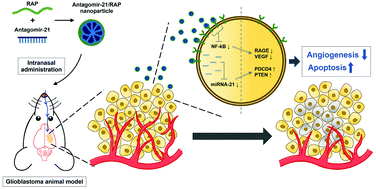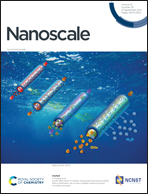Intranasal delivery of self-assembled nanoparticles of therapeutic peptides and antagomirs elicits anti-tumor effects in an intracranial glioblastoma model†
Abstract
MicroRNA-21 (miR-21) is involved in the progression of glioblastoma through inhibition of pro-apoptotic genes. Antisense RNA against miR-21 (antagomir-21) has been developed as a potential therapeutic reagent for the treatment of glioblastoma. The receptor for advanced glycation end-products (RAGE) is also involved in the progression of glioblastoma through induction of angiogenic factors. Therefore, RAGE-antagonist peptide (RAP) is proposed to be an anti-tumor reagent. In this study, self-assembled nanoparticles were produced solely with therapeutic agents, antagomir-21 and RAP, with no additional carrier. The therapeutic effects of the nanoparticles by intranasal delivery were evaluated in intracranial glioblastoma animal models. First, physical characterizations such as size/zeta-potential study, scanning electron microscopy, and gel retardation assays showed that antagomir-21 and RAP formed stable nanoparticles without any additional reagents. The ratio between antagomir-21 and RAP was optimized by an in vitro cellular uptake study. The antagomir-21/RAP nanoparticles were administrated intranasally in the intracranial glioblastoma animal models to bypass the blood–brain-barrier. As a result, the nanoparticles reduced the miR-21 levels in tumors. Inhibition of miR-21 by the nanoparticles induced the expression of pro-apoptotic genes, such as PTEN and PDCD4, which enhanced tumor cell apoptosis. In addition, the expression of RAGE was suppressed by the nanoparticles, resulting in decreased levels of vascular endothelial growth factor in the tumor. The reduction of CD31-positive endothelial cells confirmed the anti-angiogenic effects of the nanoparticles. The results indicate that the intranasal delivery of the self-assembled nanoparticles of antagomir-21 and RAP is an efficient treatment of glioblastoma.



 Please wait while we load your content...
Please wait while we load your content...